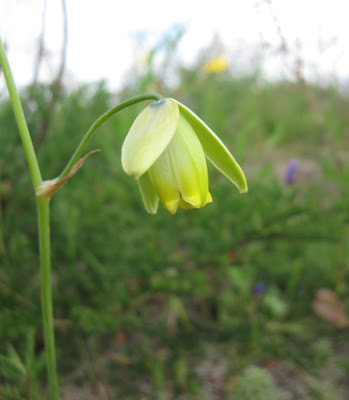Iridaceae and a walk on Rondebosch Common with John Manning
 Today I attended a talk on how to identify various members of the family Iridaceae by John Manning, Senior Specialist Scientist at the Compton Herbarium, South African National Biodiversity Institute, Kirstenbosch. The lecture was organized by Ismail Ebrahim, manager of the Cape section of the the dynamic and successful Custodians of Rare and Endangered Wildflowers (CREW) programme of SANBI's Threatened Species Programme. The lecture, in true John Manning style, was superb and I will now have to buy John's latest book The Iris Family: Natural History and Classification. (Have a quick e-preview of it here.) John is extremely knowledgeable as well as a talented artist and photographer as his many books attest to. In his introduction to John before the lecture, Ismail mentioned that it is always to a book with John's name in the list of authors that ones inevitably turns when needing information on South Africa's wildflowers. (My all time favourite book is Southern African Wild Flowers: Jewels of the Veld by John Manning and Colin Paterson-Jones, a simply wonderful introduction to our indigenous wildflower heritage.)
Today I attended a talk on how to identify various members of the family Iridaceae by John Manning, Senior Specialist Scientist at the Compton Herbarium, South African National Biodiversity Institute, Kirstenbosch. The lecture was organized by Ismail Ebrahim, manager of the Cape section of the the dynamic and successful Custodians of Rare and Endangered Wildflowers (CREW) programme of SANBI's Threatened Species Programme. The lecture, in true John Manning style, was superb and I will now have to buy John's latest book The Iris Family: Natural History and Classification. (Have a quick e-preview of it here.) John is extremely knowledgeable as well as a talented artist and photographer as his many books attest to. In his introduction to John before the lecture, Ismail mentioned that it is always to a book with John's name in the list of authors that ones inevitably turns when needing information on South Africa's wildflowers. (My all time favourite book is Southern African Wild Flowers: Jewels of the Veld by John Manning and Colin Paterson-Jones, a simply wonderful introduction to our indigenous wildflower heritage.)The lecture was followed by a guided walk on Rondebosch Common, one of our precious remnants of Sand Plain Fynbos and lowlands renosterveld.
 There were lots of Sparaxis bulbifera - and this photo shows the style dividing into three branches as well as a characteristic of all Sparaxis plants: the dry papery or crinkly bract that is irregularly fringed and streaked with brown.
There were lots of Sparaxis bulbifera - and this photo shows the style dividing into three branches as well as a characteristic of all Sparaxis plants: the dry papery or crinkly bract that is irregularly fringed and streaked with brown. The small Moraea fugacissima - its fringed stigma just showing.
The small Moraea fugacissima - its fringed stigma just showing. Trachyandra hispida - a low growing member of the Aloe family (Asphodelaceae) with membranous sheaths around the base of the stem.
Trachyandra hispida - a low growing member of the Aloe family (Asphodelaceae) with membranous sheaths around the base of the stem. The newly created parking place on the Common.
The newly created parking place on the Common. Hairy caterpillar.
Hairy caterpillar. Albuca juncifolia (back from its little sojourn in Ornithogalum). A member of the Hyacinth family (Hyacinthaceae).
Albuca juncifolia (back from its little sojourn in Ornithogalum). A member of the Hyacinth family (Hyacinthaceae). John Manning.
John Manning. Romulea rosea - very common on the Common.
Romulea rosea - very common on the Common. Romulea obscura - not so common. Apparently its all in the shape of the corms as to which species belongs to which.
Romulea obscura - not so common. Apparently its all in the shape of the corms as to which species belongs to which. Felicia heterophylla - the True Blue Daisy - with visitors.
Felicia heterophylla - the True Blue Daisy - with visitors. The hairiness of this little Sunflax is the clue to its identity: Heliophila africana. Devil's Peak in the background. I am always amazed at what one sees on Rondebosch Common - whenever one goes there, there is something new flowering. This is just a selection of what we saw.
The hairiness of this little Sunflax is the clue to its identity: Heliophila africana. Devil's Peak in the background. I am always amazed at what one sees on Rondebosch Common - whenever one goes there, there is something new flowering. This is just a selection of what we saw.
Comments